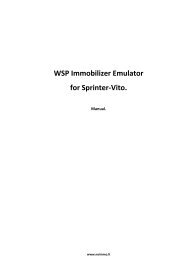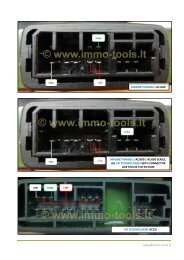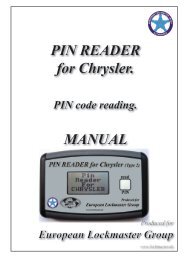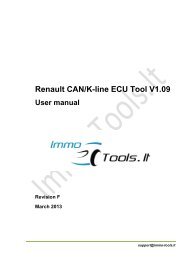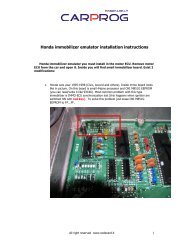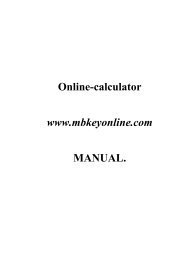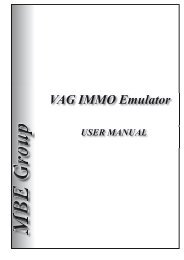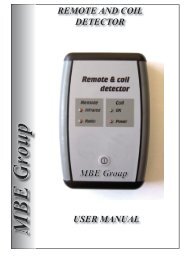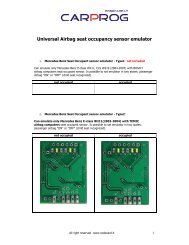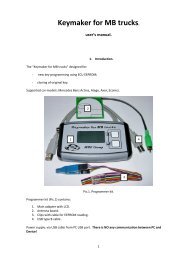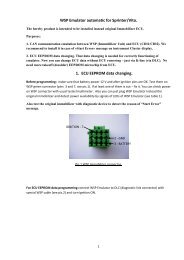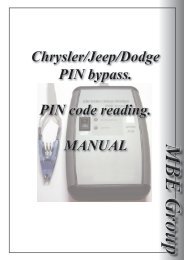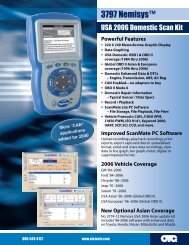BMW KeyCoder user manual
BMW KeyCoder user manual
BMW KeyCoder user manual
Create successful ePaper yourself
Turn your PDF publications into a flip-book with our unique Google optimized e-Paper software.
<strong>BMW</strong> <strong>KeyCoder</strong><br />
Ultimate tool for<br />
<strong>BMW</strong> Car Access System
<strong>BMW</strong> <strong>KeyCoder</strong> Version 0.983 (January 2012)<br />
1. Overview<br />
1.1. Introduction<br />
<strong>BMW</strong> <strong>KeyCoder</strong> software is the most powerful tool for tasks related with Car<br />
Access System (CAS * ) which is installed in all modern <strong>BMW</strong>, Mini and Rolls-Royce<br />
cars. The software can perform a wide range of tasks, and all of them can be done<br />
via OBD-II socket in seconds without disconnecting CAS from the car.<br />
Why <strong>BMW</strong> <strong>KeyCoder</strong> is the best? Here are some examples:<br />
- Programming of key – now it’s as simple as 1-2-3! Select type of key, its<br />
position and start the programming!<br />
- Programming of key is going directly in the ignition lock! No need for<br />
additional programmers and preparations of keys!<br />
- Support of latest technologies from <strong>BMW</strong>:<br />
1) EWS4 Secret Key (new 128-bit synchronization with engine control unit).<br />
<strong>BMW</strong> documentation “says” that noone can read or write it, but we can do it<br />
through OBD-II socket! Surprise!<br />
2) SOPT (encryption of keys and synchronizations with engine control unit).<br />
Now the keys can be programmed even for encrypted CAS! And even with<br />
encrypted EWS4 Secret Key, and now it’s the first software that can do it!<br />
- added in ver. 0.983: mechanical code (cutting code) of keys (HA000xxxxx) , writing<br />
wake-up pattern.<br />
1.2. Supported cars<br />
<strong>BMW</strong> <strong>KeyCoder</strong> supports CAS modules installed on:<br />
● <strong>BMW</strong> 1 series<br />
- E81 (2007 – present)<br />
- E82 (2007 – present)<br />
- E87 (2004 – present)<br />
- E88 (2007 – present)<br />
● <strong>BMW</strong> 3 series<br />
- E90 (2005 – present)<br />
- E91 (2005 – present)<br />
- E92 (2006 – present)<br />
- E93 (2007 – present)<br />
● <strong>BMW</strong> 5 series<br />
- E60 (2003 – 2010)<br />
- E61 (2003 – 2010)<br />
● <strong>BMW</strong> 6 series<br />
- E63 (2003 – 2010)<br />
- E64 (2003 – 2010)<br />
● <strong>BMW</strong> 7 series<br />
- E65 (2001 – 2008)<br />
- E66 (2001 – 2008)<br />
- E67 (2001 – 2008)<br />
- E68 (2005 – 2007)<br />
- all acronyms descriptions can be found in the Appendix<br />
● <strong>BMW</strong> X1<br />
- E84 (2009 – present)<br />
● <strong>BMW</strong> X5<br />
- E70 (2006 – present)<br />
● <strong>BMW</strong> X6<br />
- E71 (2008 – present)<br />
- E72 (2009 – present)<br />
● <strong>BMW</strong> Z4<br />
- E89 (2009 – present)<br />
● Mini One, Cooper<br />
- R55 (2007 – present)<br />
- R56 (2006 – present)<br />
- R57 (2008 – present)<br />
● Rolls-Royce Phantom, Drophead, Coupe<br />
- RR1 (2002 – present)<br />
- RR2 (2006 – present)<br />
- RR3 (2009 – present)<br />
Page 2
<strong>BMW</strong> <strong>KeyCoder</strong> Version 0.983 (January 2012)<br />
1.3. Supported CAS modules<br />
<strong>BMW</strong> <strong>KeyCoder</strong> supports CAS modules modifications:<br />
- CAS/ZAS<br />
- CAS/ZAS RD<br />
- CAS2<br />
- CAS3<br />
- CAS3+ (MCU: 9S12XDP512)<br />
1.4. Features and possibilities<br />
<strong>BMW</strong> <strong>KeyCoder</strong> allows performing wide range of tasks:<br />
● Programming of keys via OBD-II<br />
For CAS modules produced in 2010+ or updated by ISTA (up to 2.41.0 * ):<br />
- Keys or transponders can be programmed for 10-15 seconds<br />
- No need to downgrade CAS firmware<br />
- CAS with SOPT function (encrypted passwords of keys) are supported<br />
- No need for original key to program new key **<br />
- No need for additional programmer to prepare key<br />
For all CAS modules:<br />
- Programming of all keys and transponders directly in the ignition coil!!!<br />
- All keys and transponders are supported (PCF7936, PCF7942, PCF7943,<br />
PCF7944, PCF7945, PCF7952)<br />
- New keys can be programmed<br />
- Used keys with known Immobilizer Secret Key (ISK) and password can be<br />
programmed<br />
- Used keys can be transferred from other CAS or from CAS EEPROM dump<br />
- Keys with Comfort Access (ID-transmitters) can be programmed<br />
- Full access to data of all keys in CAS (only in PRO version)<br />
- Reading/writing of transponder memory and EEPROM of key directly<br />
in the ignition lock (only in PRO version)<br />
● Reading and programming of ISN *** via OBD-II<br />
For CAS modules produced in 2010+ or updated by ISTA (up to 2.41.0 * ):<br />
- No need to downgrade CAS firmware<br />
- CAS with SOPT function (encrypted ISN) are supported<br />
For all CAS modules:<br />
- ISN can be read and programmed via OBD-II<br />
● Reading and programming of EWS4 Secret Key **** via OBD-II<br />
For CAS modules produced in 2010+ or updated by ISTA (up to 2.41.0 * ):<br />
- No need to downgrade CAS firmware<br />
- CAS with SOPT function (encrypted EWS4 Secret Key) are supported<br />
For all CAS modules:<br />
- EWS4 Secret Key can be read and programmed via OBD-II<br />
* - at the moment of <strong>BMW</strong> <strong>KeyCoder</strong> release the ISTA 2.41.0 is the last.<br />
** - for cars without EWS4 mode activated. For all cars - in the next update!<br />
*** - ISN is the CAS-DME/DDE-EGS synchronization code, 3 rd generation (EWS3).<br />
**** - EWS4 Secret Key is the CAS-DME/DDE synchronization code (128-bit) used in newest cars, 4 th<br />
generation (EWS4), used in CAS3, CAS3+. See the Appendix for description.<br />
Page 3
<strong>BMW</strong> <strong>KeyCoder</strong> Version 0.983 (January 2012)<br />
● Restoring of Remote Control synchronization in the keys if it’s lost<br />
For all CAS modules:<br />
- SYNC value can be restored in key via OBD-II to make Remote Control and<br />
Comfort Access work again<br />
● Reading of ISN from DME via OBD-II<br />
For DME modules MS45 and MSV70 and all CAS modules:<br />
- ISN can be read and transferred to CAS via OBD-II<br />
● Synchronization of CAS and DME/DDE<br />
For all CAS and DME/DDE modules:<br />
- Start value can be stored in “virgin” DME/DDE module<br />
- ISN random code can be synchronized between CAS and DME/DDE if it’s lost<br />
or after writing of ISN into CAS<br />
● Deactivation of EWS function in EGS via OBD-II<br />
For all EGS modules with EWS function:<br />
- Deactivation of EWS function in paired CAS-EGS modules via OBD-II<br />
- Checking status of EWS function in EGS<br />
● Activation/deactivation of EWS4 mode via OBD-II<br />
For all CAS modules with EWS4 mode support:<br />
- Activation of EWS4 mode in CAS via OBD-II to activate exchange between<br />
CAS and DME/DDE with support of EWS4 Secret Key<br />
- Deactivation of EWS4 mode in CAS via OBD-II to activate exchange between<br />
CAS and DME/DDE with support of ISN<br />
● Synchronization of CAS and ELV via OBD-II<br />
For all CAS modules:<br />
- Electronic Steering Lock (ELV) can be synchronized with CAS via OBD-II<br />
● Programming of VIN via OBD-II<br />
For all CAS modules:<br />
- VIN can be read and programmed via OBD-II<br />
● Verification of VIN “check digit”<br />
For all CAS modules:<br />
- VIN can be checked – is it correct or not<br />
● Programming of User Information Fields (UIF) via OBD-II<br />
For all CAS modules:<br />
- UIF (Date of last CAS reprogramming, VIN and Software number) can be<br />
programmed via OBD-II<br />
● Extracting and decoding of Vehicle Order (FA) from CAS and LM/FRM<br />
For all CAS and LM/FRM modules:<br />
- Vehicle Order (FA) can be read and decoded via OBD-II<br />
● Increasing of amount of allowed ID-transmitters for Comfort Access<br />
For all CAS modules:<br />
- Only 2 ID-transmitters can be used in the car by default. Max. amount of<br />
ID-transmitters can be increased via OBD-II (ex. if you want to add new key<br />
to the car with Comfort Access)<br />
Page 4
<strong>BMW</strong> <strong>KeyCoder</strong> Version 0.983 (January 2012)<br />
● Blocking and unblocking of keys; setting of key memory number<br />
For all CAS modules:<br />
- Every key can be blocked in case of key loss or unblocked again.<br />
- Individual settings number for key can be changed (key memory)<br />
● Clearing of fault memory in the CAS<br />
For all CAS modules:<br />
- Fault memory (DTC’s) can be erased<br />
● Restarting of CAS firmware<br />
For all CAS modules:<br />
- CAS firmware can be restarted in case of any faults in CAS work<br />
Possibilities that will be fully functional in the nearest update:<br />
● Mileage correction in all CAS modules via OBD-II<br />
● Modification of Vehicle Order (FA)<br />
● Reading and programming of EEPROM of CAS3/CAS3+ via OBD-II (as it<br />
stored in MCU) (only in PRO version)<br />
2. Installation<br />
2.1. Installing software<br />
Just unpack the archive bmw-keycoder.zip to any folder and <strong>BMW</strong> <strong>KeyCoder</strong><br />
software is ready to use.<br />
Unpacked software should consist of files and folders:<br />
- “Drivers” – folder with drivers for USB-to-OBD-II device<br />
- “<strong>BMW</strong>-<strong>KeyCoder</strong>.exe” – <strong>BMW</strong> <strong>KeyCoder</strong> software<br />
- “<strong>BMW</strong> <strong>KeyCoder</strong> <strong>user</strong> <strong>manual</strong>.pdf” – this <strong>manual</strong><br />
- “Car Access System.pdf” – the part of <strong>BMW</strong> documentation<br />
- “Electronic vehicle immobilization 4.pdf” – the part of <strong>BMW</strong> documentation<br />
2.2. Installing drivers<br />
Connect USB-to-ODB-II device to OBD-II socket of the car to power-up the device.<br />
The “new hardware found” dialog will appear. Perform <strong>manual</strong> drivers installation<br />
from specified folder (for example: “C:\<strong>BMW</strong>-<strong>KeyCoder</strong>\Drivers”).<br />
Install process may differ in various Operating Systems (OS). See the examples of<br />
install process for your OS at:<br />
http://www.ftdichip.com/Support/Documents/InstallGuides.htm<br />
Here you can find guides for various OS. Download the guide for your OS and see<br />
the section “Installing CDM Drivers”.<br />
USB-dongle drivers will be installed automatically when you insert the dongle into<br />
USB-port. It will appears as USB Human Interface Device (HID).<br />
Page 5
<strong>BMW</strong> <strong>KeyCoder</strong> Version 0.983 (January 2012)<br />
3. Using the software<br />
3.1. Beginning<br />
When you start the <strong>BMW</strong> <strong>KeyCoder</strong> you will see the start window:<br />
To start work with car press “Read CAS” button (don’t forget to connect USB-to-<br />
ODB-II device and USB-dongle).<br />
All data from CAS will be read (ID, keys, car data and synchronizations). Read<br />
operation will take approximately 10-20 seconds. At the bottom of the window you<br />
can see the status of the operation.<br />
Page 6
<strong>BMW</strong> <strong>KeyCoder</strong> Version 0.983 (January 2012)<br />
If all is OK you will see the “green” status at the bottom.<br />
Also at the bottom you can see brief information about CAS and its state.<br />
CAS variant – generation of CAS module (CAS/ZAS (RD), CAS2 or CAS3/3+);<br />
Part number – main number that can “say” version of the firmware inside the<br />
CAS;<br />
SOPT active – state of the SOPT function. Active state means that keys data, ISN<br />
and EWS4 Secret Key are encrypted;<br />
EWS4 active – state of EWS4 mode. Active state means that EWS4 Secret Key is<br />
used to authenticate CAS and DME/DDE. In inactive state ISN is used;<br />
VIN – Vehicle Identification Number.<br />
Button “More info” moves you to the window with widened identification data:<br />
Here you can see more identification data. Also from this window you can clear<br />
faults memory (DTC's) with “Clear all faults” button and restart firmware of the<br />
CAS with “Restart CAS” button.<br />
Page 7
<strong>BMW</strong> <strong>KeyCoder</strong> Version 0.983 (January 2012)<br />
3.2. Navigation and sections<br />
All functions of the <strong>BMW</strong> <strong>KeyCoder</strong> are divided by sections: “Main”, “Keys”, “Car<br />
data”, “Synchronizations” and “CAS EEPROM dump”.<br />
They can be accessed by clicking on the tabs at the top of the window...<br />
... and then selecting subsections in the left menu.<br />
Or you can access functions directly from the start window:<br />
Click on the button or blue link to open the function’s window.<br />
Page 8
<strong>BMW</strong> <strong>KeyCoder</strong> Version 0.983 (January 2012)<br />
3.3. Section “Keys”<br />
In the section “Keys” you can find 5 subsections, each of them allow to perform<br />
different functions:<br />
Program new key – programming of “empty” transponder, key with remote<br />
control or ID-transmitter. Appropriate data will be programmed from CAS into key<br />
inserted in the ignition coil.<br />
Program used key – programming of used key with known configuration. The<br />
data from the key will be programmed into CAS.<br />
CAS editor gives you full access to data of all keys programmed in the CAS (only<br />
in PRO version).<br />
Key editor allows you to read and write transponder memory and EEPROM data<br />
of the key inserted in the ignition coil (only in PRO version).<br />
Additional – here you can find several functions: 1) restoration of remote control<br />
synchronization value, 2) changing of maximum amount of ID-transmitters in car<br />
with Comfort Access, 3) blocking and unblocking of keys, changing “key memory”<br />
index.<br />
3.3.1. Programming of new key<br />
Programming of new key is very simple. To program new key you should do only 3<br />
simple steps:<br />
1) Select type of key<br />
2) Select position of key<br />
3) Press “Start key programming” button<br />
Page 9
<strong>BMW</strong> <strong>KeyCoder</strong> Version 0.983 (January 2012)<br />
The key you want to program should be with default configuration, i.e. ISK low<br />
should be equal to 4D494B52, ISK high – 4F4E, PSW – AA4854.<br />
Important notice! Transponder's (PCF7936) CFG byte should be equal to 0E,<br />
i.e. transponder should be in cipher mode. By default from factory all<br />
transponders are supplied with CFG = 06 (password mode). But CAS can't<br />
recognize transponder in password mode. So you should turn transponder in<br />
cipher mode (CFG = 0E) with any HITAG2 programmer before try to program it<br />
to car.<br />
Step-by-step instructions<br />
Here are exact steps to program new key from the beginning:<br />
1) Start the software<br />
2) Click "Read CAS" button and wait while car is being read.<br />
3) Go to "Keys" - "Program new key" window<br />
4) Select type of key<br />
5) Select position of key<br />
6) Click "Start key programming"<br />
Note that when you click "Start key programming" there must be no key in the<br />
ignition coil. You should insert new key only when this prompt appears:<br />
7) Insert new transponder, key or ID-transmitter into ignition coil and click "Yes"<br />
8) Wait while key is being programmed<br />
9) Remove programmed key from ignition coil and insert it again to start the car<br />
If after step 6 you’ll see this message you should repeat all sequence from step<br />
2 and insert a working key for this car at step 2<br />
Page 10



